This section allows you to view all posts made by this member. Note that you can only see posts made in areas you currently have access to.
Messages - critor
Pages: 1 ... 119 120 [121] 122 123 ... 137
1801
« on: November 22, 2010, 02:50:57 pm »
Wow I didn't knew about the 9800G  . I was sure the first color calc was in 1996 with the FX-9850G+, which has a 128x64 LCD. Also I was sure it was 3 colors, not 4. My CFX-9860G has orange, blue and green. . I was sure the first color calc was in 1996 with the FX-9850G+, which has a 128x64 LCD. Also I was sure it was 3 colors, not 4. My CFX-9860G has orange, blue and green.
I wish ASM was possible without flashing the ROM chip on those models. Even with 3-4 colors, imagine what you could do in ASM by quickly flashing some pixels (like we do on the 83+ for grayscale) or if you could change the color palette how you want. It would be epic.
Even with 3 colors + the LCD color it wouldn't be that bad for a calculator. Mockup of what could have been FF1 if the CFX-9850G got jailbreaked back when it was still in production:
Yes, you're right. 2-bits = 4 different colors But those 4 different colors include the state where the pixel is turned off (which is "blank" or "black", depending upon he screen). So that's only 3 displayed colors, but still 4 "colors" for your games/pictures.
1802
« on: November 22, 2010, 10:00:10 am »
The sellers' overall ratings actually look pretty good. Mostly 4s and 5s. According to some of them, they're just preordering, so they start shipping when the calculators actually come out. Kinda early for ordering though, if you ask me.
I mean, it's one of the firsts colored calculators, people think it is awesome just because of that :S
Not one of the firsts.. The 1st color graphic calculator is the cfx-9800G, and was released by Casio in 1993. It had a 96x64 LCD. The 2-bit encoding of the colors made it able to display 4 different colors. But Casio calculators were just crap at the end of the last century... Since then, Casio has released other color graphic calculators with a better 128x64 screen (larger than the TI-82/83/83+/84 screen): fx-9970G (1998), cfx-9860G+/GC+ (2004) But they were still using a 2-bit color encoding, so only supporting 4 colors without assembly. The Prizm is not going to be the first color graphic calculator, but the first graphic calculator with a 16-bit color encoding, making it able to display 65536 different colors.
1803
« on: November 21, 2010, 05:21:04 pm »
I don't know, but I guess a logical next step would be to compare that picture with the PCB from a newer 83+ or 73.
The difficulty, it that most ASIC pin connections are not visible on the recent TI-83+/73. I suppose they are on the other site of the PCB... Here is the same ASIC on a recent TI-83+ PCB: 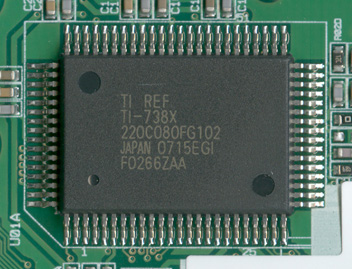 (source: http://www.datamath.org ) (source: http://www.datamath.org )Same problem with recent TI-73.
1804
« on: November 21, 2010, 05:01:42 pm »
I've figured out some more pins of the TI-738X ASIC (used in TI-82Stats.fr, TI-76.fr, recent TI-83+, and recent TI-73). I don't know if I'll ever come out with something, but I'm posting the pinout as it can be usefull to TI-83+/TI-73 users/hackers too:  Let's sum up things. The TI-83+, TI-73, TI-82Stats.fr and TI-76.fr all use the same ASIC. But on the TI-82Stats.fr and TI-76.fr, the ASIC operates in TI-83 (basic) mode, which lets it run a 256Kb TI-83 OS, although the ROM capacity is 512Kb. So the main question is: how is it possible for the same ASIC to operate both in TI-83+/TI-73 mode and in TI-83 basic mode, depending upon the model it is used in? Is the ASIC configured during production through a high voltage or some kind of flashing? Or, is it configured by the PCB itself, using some kind of jumper by connecting or not connecting its pins? If you know more than me about ASICs, what do you think it is?
1805
« on: November 20, 2010, 07:03:54 am »
Any chance of the PDF in english? If someone speaking english natively wants to translate, I can provide the latest OpenOffice file. Any EDIT4: How do I send an "add-in" to the fx-9750gii using FA-124? After flashing the calculator with an OS supporting "add-in", you've got to switch between "main memory" and "storage memory" using the buttons to the right of the calculator view toolbar in FA-124. GOT IT TO WORK!
So, are you happy with your new calculator?  How was the google-translated tutorial?
1806
« on: November 17, 2010, 06:15:08 pm »
Remember I wanted to upgrade the cheap TI-82Stats/76.fr (= TI-83) with a great TI-83+ OS ? http://ourl.ca/7922I couldn't do it up to now, but... I have managed a similar upgrade with Casio!   Just upgrade your cheap Graph 35+USB / fx-9750Gii (= TI-83) with a great Graph 85/75 / fx-9860G/Gii OS (=TI-84+SE). In fact, the Graph 35+USB / fx-9750Gii have a 4Mb Flash ROM. But the installed OS doesn't provide any archive memory, and doesn't accept applications. And officially, there is no official software to flash an OS on that model. After flashing the model with one of the OSes mentionned above, you get: * archive memory support! (1.5Mb)* application support! The hack is simple (long but simple). No hardware modification -> no special tools needed -> free updrade. Could some french-speaking people check and try to upgrade their Graph 35+USB / fx-9750Gii ? http://casio.bank.free.fr/index.php?mod=archives&ac=voir&id=127I'll post a news once the tutorial will have been tested. Thanks. Let's all migrate to Casio! Much more upgradable calculators!(if you have a cheap scientific fx-82ES / fx-83ES / fx-85ES / fx-92 Collège 2D calculator, you may also try this tutorial in order to upgrade it with a simple pencil -> http://casio.bank.free.fr/index.php?mod=archives&ac=voir&id=93 )
1807
« on: November 15, 2010, 10:02:04 pm »
I understand Brandon. But I'm still wondering. If you look at recent PCB scans on DataMath.org, you'll notice that all four TI-76.fr, TI-82Stats.fr, TI-83+ and TI-73 calculators are using the same ASIC: TI-REF TI-738X 220C080FG102 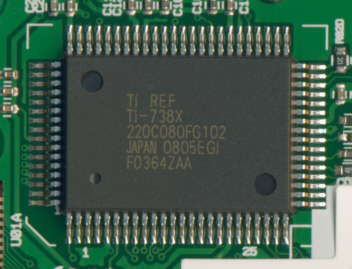 So is it really the same chip? And if it is, then there must have been some way for TI to configure it, internally or externally, in order to operate in TI-83 mode or in TI-73/83+ mode. What's your advice?
1808
« on: November 15, 2010, 07:39:30 pm »
Now if only it was as easy as on some Casio calcs, where you just black out something on the motherboard and your calc becomes a new one... (as described on Casio-BANK) 
(For those who understand french and are curious, this is what I mean, but the link is currently not working because Free.fr hosting provider is terrible: http://casio.bank.free.fr/modules/archives/downloads/C2Dupgrade.pdf )
Yes, it would be great if I could make such a "simple" tutorial to upgrade the TI-82Stats.fr and TI-76.fr.
1809
« on: November 15, 2010, 07:29:09 pm »
If it can run TI-83 or TI-83+ assembly programs, I could probably write a program to flash it.
I can run all TI-83 assembly programs on the TI-82Stats.fr and TI-76.fr. Even shells/kernels. I don't know how the calculator would react to TI-83+ assembly code... And I don't understand how the same ASIC can execute both TI-83 and TI-83+ assembly codes, as there are some differences... Or can the TI-738X ASIC be configured in some way during production to work either as a TI-83 either as a TI-83+? Internally or externally through some kind of jumper/flag for example?...
1810
« on: November 15, 2010, 07:23:24 pm »
Oh, from what I read in your post, it seemed like we wouldn't be able to upgrade the TI-83 ROM to a TI-83+ OS, as you mentionned some flash pages were not accessible. Of course maybe it would be possible with modifications, but I specifically meant for people who don't want to modify their hardware. I migth have misunderstood you, though, but I know nothing about hardware.
Don't worry. I may not have found the best words to explain things. Well, I hope we can find a way with only small hardware modifications. (like disconnecting a pin, and connecting 2 pins...) Anyway, I've started my own topic and given all my informations again. It was a little off-topic here, sorry about that. http://ourl.ca/7922
1811
« on: November 15, 2010, 07:06:24 pm »
The TI-82Stats.fr and TI-76.fr are 2 cheap graphic calculators available in France. They include a 256Kb TI-83 compatible OS translated in french. (TI-Connect detects them as TI-83 calculators - TI-83 assembly programs are working on them - and the dumped ROMs can be used with any TI-83 emulator)But those calculators become quite interesting when you look at the PCB: TI-76.fr: http://www.datamath.org/Graphing/Images/TI-76FR_PCB.jpgTI-82Stats.fr: http://www.datamath.org/Graphing/Images/TI-82STATS_FR_P0509G_PCB.jpg1st big surprise, unlike TI-83 calculators they don't have a 256Kb EPROM, but a 512Kb FlashROM. The FlashROM is either a Spansion S29AL004D70 either a MX29LV400, which are both pin compatible and used in recent TI-73 and TI-83+ calculators. 2nd big surprise, the CPU/ASIC is a TI-REF TI-738X, which is also used in recent TI-73 and TI-83+ calculators. So, the TI-76.fr and TI-82Stats.fr PCB are very similar to recent TI-73 or TI-83+ PCB: TI-73: http://www.datamath.org/Graphing/Images/TI-73_P0803G_PCB.jpgTI-83+: http://www.datamath.org/Graphing/Images/TI-83PlusFR_PCB.jpgSo, my goal is to develop a simple way to flash a TI-83+ or TI-73 OS in those calculators.I'm posting my discoveries, hoping that you will be able to help me.I've checked the connections between the FlashROM and the ASIC chips on the TI-76.fr and TI-82Stats.fr. Here is what I have up to now: Legend:
In black, pins not connected to the PCB circuit.
In white,grounded pins.
Connected pins are in the same color.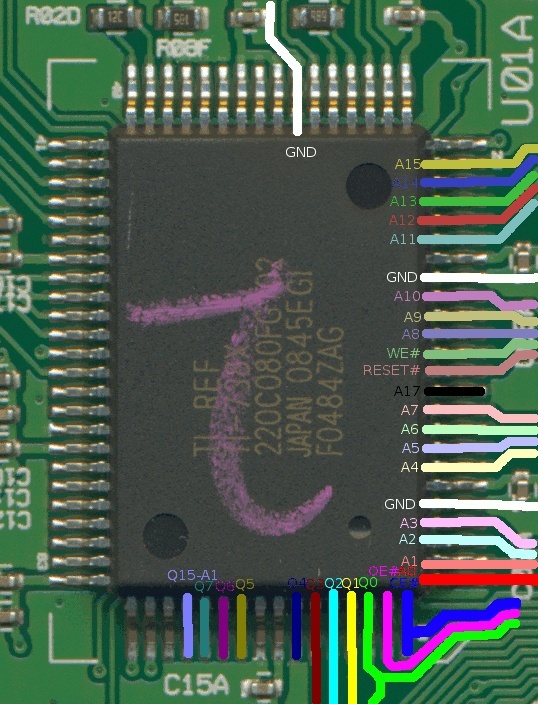 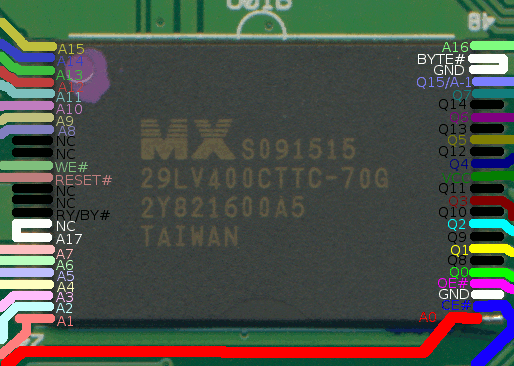 As FloppusMaximus had noticed, the flash-write pin WE# is connected to the ASIC. So from the hardware side, the ROM can be flashed. The highest flash address pin, A17, is grounded. So you cannot accesss the full 512Kb bytes, but only the 1st 256Kb bytes. Checking in a recent TI-83+, I could find the matching A17 pin on the ASIC. You just have to: - disconnect A17 flash pin from ground - connect A17 flash pin to A17 ASIC pin 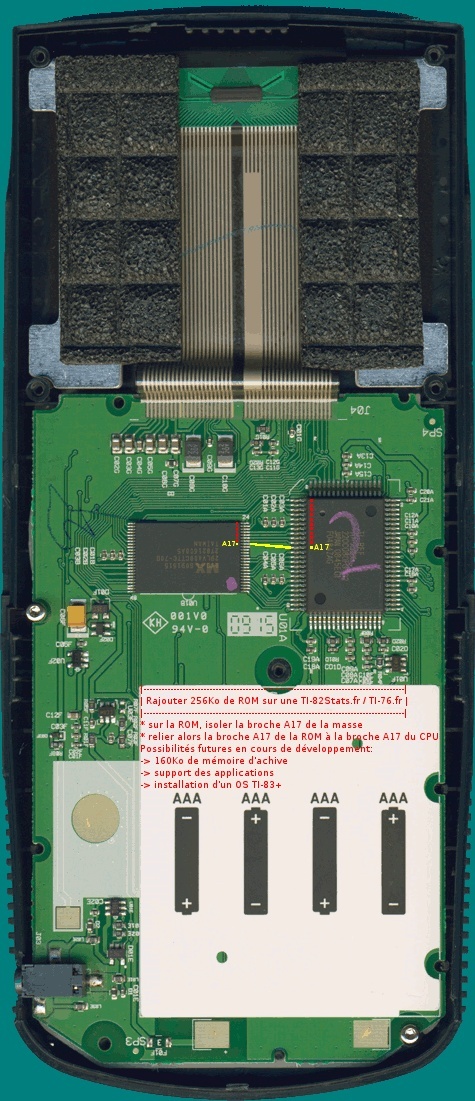 Now, from the hardware-side, the full 512Kb bytes can be accessed. Unfortunately, I haven't managed to trigger any boot code menu using the ON+DEL key. To my knowledge, the 256Kb dump file is a standard TI-83 OS. That means: - no boot code - no functions to write the flash - impossible to access more than 256Kb ROM So, I cannot even dump the hidden 256kb to check for a boot code... So I'm asking for the help of the best TI-83/83+ programmers/hackers out there. How could we manage to flash a TI-83+ boot code and then a TI-83+ OS ? I also have some questions: - How is it possible for the same ASIC to be able to run both TI-83 and TI-83+ OSes ? I thought that many ports were behaving differently on those calculators... How are the ports behaviors set up ? - How is it possible for the same ASIC to be able to boot with or without a boot code? TI-83+ calculators have a boot code in the last 16Kb sector of the ROM... To my knowledge, there is no such boot code in the 256Kb TI-82Stats.fr / TI-76.fr dump files, and even if such a boot code was written higher in ROM, it could not be accessed before moding the calculator as explained above. If we manage to come out with a not to complicated mod, many french students will be very happy. Please, help me.
1812
« on: November 15, 2010, 12:31:46 pm »
This also means the OS would not be upgradeable, right?
Why?... Physically, it can be upgraded, by pluging the Flash-chip in an EPROM programmer. But the probability I just break the calculator doing something like that is over 99%. I'm looking for a simpler way, a 100% software-way, or a way which would only require some minor hardware modifications.
1813
« on: November 15, 2010, 12:25:53 pm »
That's very interesting. I wonder if the Flash chip is actually upgradeable. Going by this image from Datamath, it looks like the write-enable pin (pin 11) is in fact connected to the ASIC, so it's possible. But it's hard to imagine that they would have put user-upgradeable Flash in a calculator without including an 83+-style boot code.
Seems the A17 Flash-ROM pin is not connected. So without a hardware modification, the ASIC (which is the same as on the TI-73/83+: a TI-REF/TI-738X) cannot read/write anything in ROM beyond 0x3FFFFh. So, if there is some boot code, the ASIC cannot access it. So I'm wondering... When there is a power-loss on a TI673/83+/84+, is the boot code executed before the OS? How does the ASIC know where to look for the boot code? Is it the boot code which checks for the "DEL" key being pressed? Thanks. Today, I've looked into the ASIC-Flash connections on the TI-82Stats.fr. (probably identic to the TI-76.fr)Here is what I have figured out: In black, unused pins. In white, grounded pins. Connected pins are in the same color. 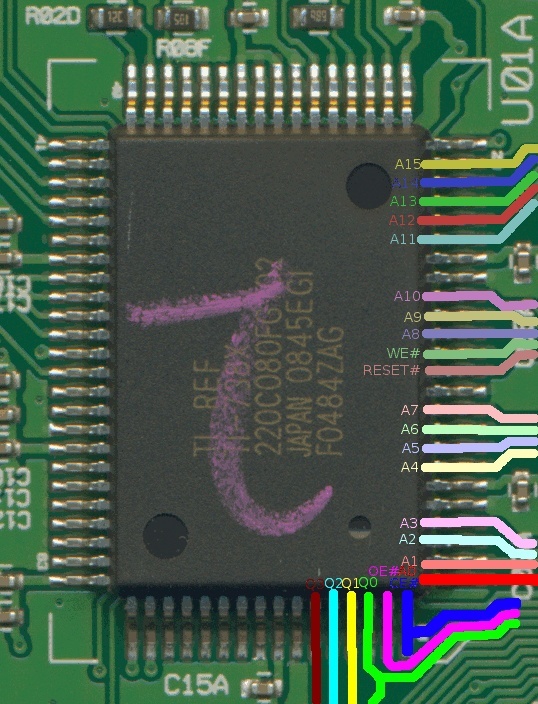  I've managed to un-ground the A17 Flash pin, and connect it to the ASIC pin between RESET# and A7. (don't know if it is the right one)Anyway, I didn't manage to trigger a boot code after that using the DEL key.
1814
« on: November 14, 2010, 05:34:21 pm »
Very interesting FloppusMaximus.
Let me tell you what I have in mind.
You know that Brandon has developped a way to install a TI-83+ OS on a TI-73.
In France, we don't have the TI-73, but we have cheap calculators that aren't available in North-America: the TI-82Stats.fr and the TI-76.fr.
They are running special french-translated TI-83 compatible OSes (TI-Connect does detect them as TI-83, and TI-83 assembly programs can be run without any problem).
The TI-82Stats.fr has got the 1.11fr7 ROM version.
The TI-76.fr has got the 1.00fr5 ROM version.
But although the OS is TI-83 compatible, the motherboard is very similar to the latest TI-83+ motherboards.
And although a dump file is only 256Kb large, the calculator does include a 512kb Flash-ROM.
It would be very interesting if we could find some way to flash a (patched) TI-83+ OS in those Flash-ROM.
Unfortunately, DEL+ON doesn't seem to trigger any boot code menu.
And I cannot check if the boot code is there, because it is supposed to be at the end of the 512Kb ROM.
And using TI-83 assembly code, I cannot check anything beyond the 1st 256Kb of the ROM.
1815
« on: November 14, 2010, 12:28:11 pm »
Yeah, I guess you could. It would take some effort to get the OS to run properly on an 83+, but it could be done. (Of course, some assembly programs wouldn't work properly, but many of them probably would.)
In theory, what would have to be changed in order to make a TI-83 OS run on a TI-83+ hardware/emulator?
Pages: 1 ... 119 120 [121] 122 123 ... 137
|
. I was sure the first color calc was in 1996 with the FX-9850G+, which has a 128x64 LCD. Also I was sure it was 3 colors, not 4. My CFX-9860G has orange, blue and green.










